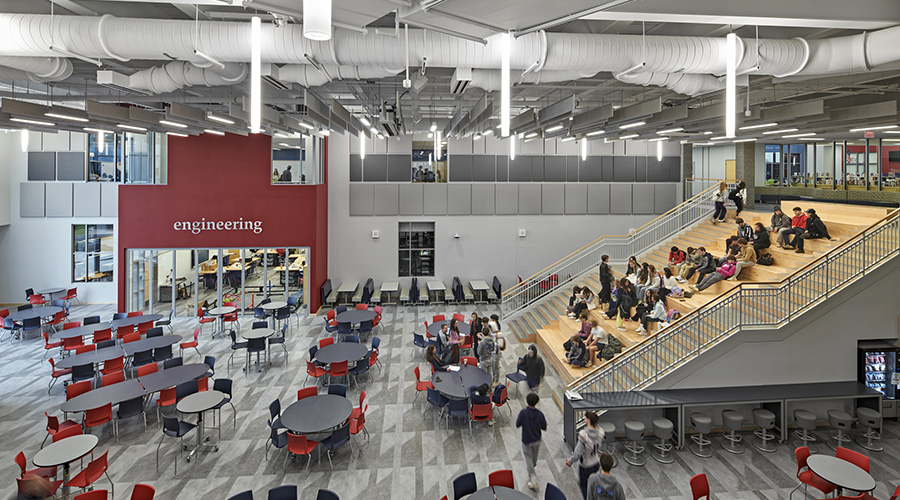Las Vegas Schools Endure Growing Pains
38 new schools in three years and 1,000 new students a month. Here�s how the maintenance department for the Clark Co. (Nev.) School District keeps pace with frantic expansion
Clark County, Nev., the home of Las Vegas, is growing. And its rampant population growth — fueled by Las Vegas’ gaming opportunities, sunny climate and favorable economy — shows no signs of slowing down.
The 8,000-square-mile Clark County School District — which is geographically larger than several states on the eastern seaboard — has a student population of 255,000, a number that nearly doubled during the last decade. That kind of explosive growth has left Jerry Smith, director of maintenance for the district, facing numerous challenges.
“This year, as in years past, we’ll build about one new school per month,” he says. Despite this feverish building pace, Smith says the Clark County district isn’t that different than other districts.
“We’re all in the same boat: Too much to do with too little budget,” he says. “Our challenges aren’t really that different than anybody’s else’s.”
Keeping Pace
A present growth rate of 1,000 new students each month sometimes leaves Clark County School District’s maintenance department struggling to keep pace.
“This year and next will be terrible for budgeting,” Smith says, adding that Nevada’s budget allocation per student has historically been about $1,000 less than the national average. Recent growth predictions also were off — in part because the city’s tourism industry was hurt by terrorism fears.
“Ideally, we’d have 2 to 4 percent of the aggregate replacement value of our physical plant that’s set aside for routine maintenance,” he says. “We have about half a percent.”
Despite the challenges, Smith’s department copes by implementing strategies that include zone maintenance teams and a roving maintenance truck — tactics that help in the face of a surging population and a shrinking budget.
Smith says using zone teams to address problems in regions and groupings of schools in the district has been a boon t
“Making the same workers responsible for the same set of schools helps ensure that the technicians become familiar with the same equipment,” he says.
“Another strategy we use is our mobile maintenance van,” Smith says. This 48-foot truck has a stock of supplies and a small shop on board. The truck is usually parked at one of the schools for a number of days until much of the work at that school is performed. Savings come from both programs because they reduce technicians’ time in a vehicle, Smith says.
“Otherwise, guys would be spending a lot of time behind the wheel,” he says. “In a district our size, the windshield time is terrible.” Smith has another truck on the way and eventually hopes to have 10 such trucks, two for each of the district’s five regions.
Using satellite locations away from the district’s main hub has also worked to cut the district’s losses. A technician in the office machine repair department, Karyn Schierberl, recommended establishing remote bases for fellow technicians in the field when she learned that a vacancy for a copier technician would go unfilled.
The district also planned on moving the shop to a location further from work sites, Schierberl says, adding that she recommended creating field offices from which the technicians could work. Each technician now is responsible for a region with the school district that covers about 200 copiers.
“Workers operate from one school that serves as a home base,” Schierberl says. “They can receive their faxed work orders at these sites. To resupply their vans, they return to the main shop about once a week.”
Penny Saved, Penny Earned
In a district such as Clark County, where students are abundant and resources are slim, it is evident that every bit of savings can be put toward other maintenance efforts.
“Maintenance does equate purely to money,” says Derrell Obenhaus, the district’s HVAC/R supervisor. ‘The ways we can save money can come down to small things. For example, we’ll brush relays and put them back in place to get a little more use out of them rather than replacing them. We do this to protect the budget.”
Schierberl says the district can make progress in overcoming budget shortages by using every advantage. Because Las Vegas is host to many trade shows, workers in the district attend conferences and trade shows to build relationships, mainly among manufacturers and suppliers. Schierberl says she has used these contacts to help the district save money.
“When pitted against one another, vendor pricing can get very competitive,” she says. For example, Schierberl has about eight vendors who can supply copier drums.
“I can buy those drums retail for about $65,” she says. “But with vendor competition, I’ve bought them for as little as $9.50.
Product buyers in the district, however, know that savings often arise from focusing on product quality, not first cost.
“Buy quality,” says John Bowers, the district’s lock shop supervisor. “Don’t try to save a few dollars. We buy Grade 1 locksets. It would be different if we were talking about a commercial office setting, but Grade 2 or 3 locksets simply do not hold up to the students. The service life of hardware has to last for 10 years or more.”
This tactic does not imply that Bowers is unaware of the importance of cost. He and members of his staff regularly visit new schools to check specifications.
“I always carry a gauge tool with me,” he says. “The cost difference between a 14-gauge and 18-gauge steel door is quite a bit.” Prioritizing work orders also can help save money, but in Bowers’ position, his foremost concern is for security and safety.
“I feel badly when a teacher asks us to fix a lock on a desk cabinet so that her purse doesn’t get stolen and we tell her that it isn’t a high priority for us,” he says. “But we’ve got to look out for the safety and security of the students first. For example, a broken door will take precedence over a broken cabinet lock. And a slamming door can take off fingers.”
Management Matters
Challenges at the department management level are no less pressing. For example, Smith says it can be difficult to find qualified electrical and mechanical technicians. Often, he finds workers among district bus drivers and custodians.
“People want to stay in the valley,” he says. “If there’s a carpenter who can’t find that work, he might hire on as a bus driver in the district. Once you’re in the district’s system, it’s just a matter of waiting until the right position opens up. I’ve found a few of my guys that way.”
To manage the maintenance mission, the district uses a 10-year-old CMMS system.
“It was a roll-your-own system back when we bought it, and I anticipate that getting a new CMMS — one that would tie together work orders with the district’s inventory — will help,” he says.
Bond-fund renovation projects totalling $900 million for 88 schools is also helping the department keep up with its rampant growth. School renovation work essentially wipes out any deferred maintenance on the renovated buildings.
“Our schools look good because of the climate, but also because many recently have been renovated,” he says. “Visitors say they can’t believe we get so much done with so few workers, but the secret to keeping [schools] looking good is our ongoing renovations.”
Despite his maintenance challenges, Smith has concluded that the Clark County School District’s situation is not unique, based on conversations with his peers in other large, Western school districts.
“I talk to a fellow in the Jefferson County district, which includes Denver, and somebody in the Jordan River district, which is Salt Lake City.” Smith says. “Their problems are same as ours.”
Adds Obenhaus, “Our student spending is one of the lowest in the country, but the challenges aren’t really that different.”

Related Topics:












